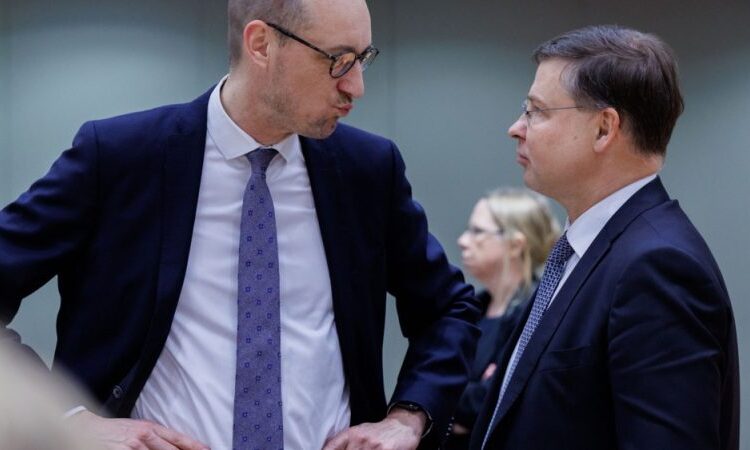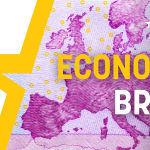
European finance ministers fell short of achieving any breakthroughs at their meeting in Luxembourg on Friday (12 April) as divisions persisted on whether to prolong the bloc’s multibillion pandemic recovery fund and how the European Investment Bank’s (EIB) lending criteria could be widened to include defence-related assets.
Belgian finance minister Vincent Van Peteghem told reporters following the meeting that there were “different views” among ministers about whether the EU’s €723.8 billion Recovery and Resilience Facility (RRF) should be extended, adding that “some member states… emphasised the one-off nature of the facility.”
Commission executive vice-president Valdis Dombrovskis, however, defended the “ground-breaking” nature of the fund, whose “design and flexibility have helped us to tackle new challenges, such as high inflation [and] energy security issues.”
“The RRF re-assured financial markets on the EU’s resolve to tackle the Covid-19 challenges, ensured a rapid flow of funds to member states in a time of great difficulty, played a key rule in preserving public investments and sustained a solid recovery, returning the EU economy to pre-pandemic levels sooner than expected,” Dombrovskis said.
Meanwhile, Van Peteghem noted that “on specific issues, further discussion is needed” on how the EIB could potentially step up support for Europe’s security and defence industry.
However, he said there was still “large support amongst ministers to move forward” with an “action plan” — the outline of which was presented to ministers on Friday by EIB president Nadia Calviño.
Before the meeting, Calviño informed reporters that her plan would include the results of a two-month investigation into the “definition” of so-called dual-use technologies, as called for by EU finance ministers in February.
The EIB’s current mandate limits the range of permissible defence-related investments to dual-use items that should be used mostly for civilian and military purposes.
Most of the technology’s expected future revenue must also derive from its civilian use.
The bank is explicitly prohibited from investing directly in weapons, ammunition, and “core” military infrastructure.
Panaceas for Europe’s investment and security needs?
The RRF and the EIB have been objects of growing attention by European policymakers in recent months.
The RRF is viewed by many as a source of much-needed financing for member states still reeling from the twin shocks of the COVID-19 pandemic and subsequent energy crisis.
However, several of the so-called ‘frugal’ EU countries — including Germany, the bloc’s largest economy — are resistant to extending the facility beyond its scheduled expiry in 2026.
Meanwhile, the EIB — the world’s largest multilateral lender by assets — is seen by many member states as a potential tool to boost European defence expenditure, as Russia’s war in Ukraine continues to rage into its third year and member states assess ways to step up their defence capacity.
Last month, the European Council “invited” the EIB “to adapt its policy for lending to the defence industry and its current definition of dual-use goods, while safeguarding its financing capacity.”
In February the European Parliament called on the bank to “enhance its support… to the European defence industry,” urging it to overhaul its investment eligibility criteria “so that ammunition and military equipment that go beyond dual-use application are no longer excluded from EIB financing.”
However, several stakeholders have expressed deep concern about the EIB’s possible move into defence-related spending, citing the possibility of the bank losing its high ESG and triple-A credit ratings.
‘No discussion of scandal’
Van Peteghem, whose country currently holds the rotating presidency of the Council of the EU, told reporters that there had been “no discussion” among ministers about the recent scandals involving RRF financing.
Last week, the European Public Prosecutor’s Office (EPPO) announced that 22 individuals had been arrested in Italy, Austria, Romania and Slovakia for embezzling €600 million in RRF funds.
In an interview with Euractiv on Tuesday (9 April), European Court of Auditors president Tony Murphy said that the facility’s scheduled expiry by the end of 2026 is “contributing to the risk” of the funds’ misappropriation by amplifying “pressure on member states to spend this money quickly.”
“That in itself inherently raises the risk of people being opportunistic and taking advantage of shortcuts or whatever might be there,” he said.
Murphy stressed that a lack of central oversight was “amplifying” the likelihood of the funds’ misuse.
His comments came on the same day that European Commissioner for Economy Paolo Gentiloni called for the RRF to be used as a “blueprint” for future EU funding programmes — arguing that the bloc would “benefit hugely from a permanent, safe asset commensurate with the size of its economy, and this will be a big issue to discuss for the next Commission.”
Agreed at the height of the COVID-19 pandemic in December 2020, the RRF comprises €385.8 billion worth of loans and €338 billion in grants, financed through debt jointly underwritten by EU member states.
The funds, the flagship component of the bloc’s NextGenerationEU (NextGenEU) initiative, are intended to boost Europe’s post-pandemic recovery by financing green, digital, and other critical investments in exchange for targeted reforms.
[Edited by Anna Brunetti/Rajnish Singh]







